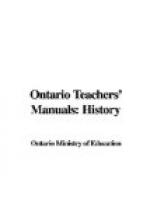3. Newfoundland and Prince Edward Island reject the proposal, and delegates from Upper Canada (Ontario), Lower Canada (Quebec), Nova Scotia, and New Brunswick proceed to London to secure an Act of Union from the Imperial Government.
4. Movement in favour of union hastened by United States giving notice in 1865 of the termination of the Reciprocity Treaty in a year, and by the Fenian Raid, 1866.
5. Union accomplished by means of the British North America Act passed by the British Parliament in 1867, and brought into force on July 1st, 1867. The provinces confederated as the Dominion of Canada; a Federal Union.
Outline of Terms:
See Ontario Public School History of Canada, p. 215. Provision made for admission of new provinces.
Expansion of Confederation:
Admission of other provinces—Manitoba, 1870; British Columbia, 1871; Prince Edward Island, 1873; Alberta and Saskatchewan, 1905; Yukon territory also represented in the Dominion Parliament.
NOTES OF A LESSON ON THE INFLUENCE OF GEOGRAPHICAL CONDITIONS ON THE HISTORY OF A COUNTRY
CORRELATION OF HISTORY AND GEOGRAPHY
GENERAL
The history of a nation is influenced very largely by geographical facts. Its internal relations, whether friendly or hostile, are affected by these. Natural barriers, such as mountains, seas, or great lakes and rivers, are often political frontiers exerting protecting or isolating influence.
Its industrial progress depends primarily upon its natural products—minerals, grains, woods, fish, etc., and the facilities which its structure affords for trade, both domestic and foreign. A sea-coast, with satisfactory harbours, tends to produce a sea-faring people, and therefore a trading people.
The character of its people is conditioned by the zone in which the nation is situated. In the north temperate zone is the climate best suited for the growth of peoples vigorous in mind and body, and lovers of freedom.
ENGLAND
Position: The forming of the Straits of Dover cut off a corner of Europe, made Great Britain an island, and later a single political unit. Situated between Europe and America with ports opening toward each, her position gives her the opportunity for naval and commercial greatness. The narrow sea separating her from the continent is a defence in war and a means of intercourse in peace.
Structure: Two regions—one of plain, the other of hills; a line drawn from the mouth of the Tees to the mouth of the Severn and continued to the south coast roughly divides these regions. The part lying east of this line is, roughly speaking, level and fertile, tempting emigration from the continent, and easily explored inward. The Angles, the Saxons, and the Jutes found their way into this plain through the rivers that flowed east and south. The Pennines, the Welsh Peninsula, and the southwest of England from Bristol are in the hilly part, which, because of its mineral wealth, has become the great industrial district.




